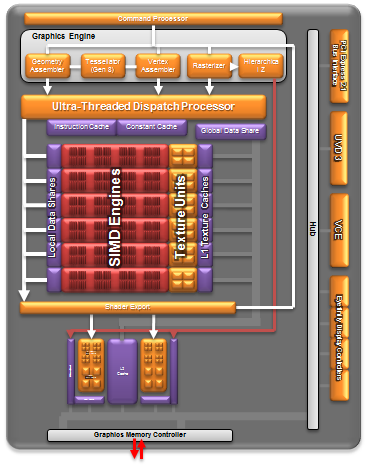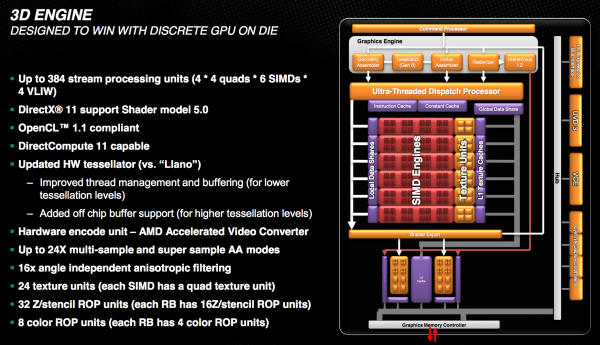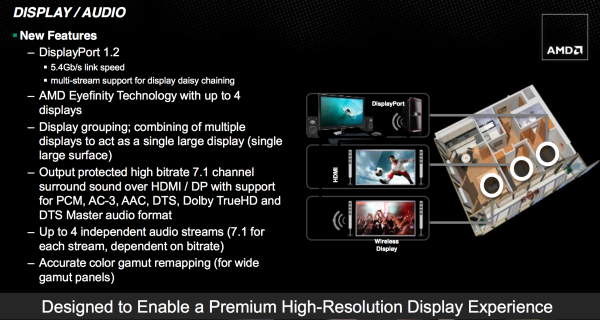The AMD Trinity Review (A10-4600M): A New Hope
by Jarred Walton on May 15, 2012 12:00 AM ESTImproved Turbo
Trinity features a much improved version of AMD's Turbo Core technology compared to Llano. First and foremost, both CPU and GPU turbo are now supported. In Llano only the CPU cores could turbo up if there was additional TDP headroom available, while the GPU cores ran no higher than their max specified frequency. In Trinity, if the CPU cores aren't using all of their allocated TDP but the GPU is under heavy load, it can exceed its typical max frequency to capitalize on the available TDP. The same obviously works in reverse.
Under the hood, the microcontroller that monitors all power consumption within the APU is much more capable. In Llano, the Turbo Core microcontroller looked at activity on the CPU/GPU and performed a static allocation of power based on this data. In Trinity, AMD implemented a physics based thermal calculation model using fast transforms. The model takes power and translates it into a dynamic temperature calculation. Power is still estimated based on workload, which AMD claims has less than a 1% error rate, but the new model gets accurate temperatures from those estimations. The thermal model delivers accuracy at or below 2C, in real time. Having more accurate thermal data allows the turbo microcontroller to respond quicker, which should allow for frequencies to scale up and down more effectively.
At the end of the day this should improve performance, although it's difficult to compare directly to Llano since so much has changed between the two APUs. Just as with Llano, AMD specifies nominal and max turbo frequencies for the Trinity CPU/GPU.
A Beefy Set of Interconnects
The holy grail for AMD (and Intel for that matter) is a single piece of silicon with CPU and GPU style cores that coexist harmoniously, each doing what they do best. We're not quite there yet, but in pursuit of that goal it's important to have tons of bandwidth available on chip.
Trinity still features two 64-bit DDR3 memory controllers with support for up to DDR3-1866 speeds. The controllers add support for 1.25V memory. Notebook bound Trinities (Socket FS1r2 and Socket FP2) support up to 32GB of memory, while the desktop variants (Socket FM2) can handle up to 64GB.
Hyper Transport is gone as an external interconnect, leaving only PCIe for off-chip IO. The Fusion Control Link is a 128-bit (each direction) interface giving off-chip IO devices access to system memory. Trinity also features a 256-bit (in each direction, per memory channel) Radeon Memory Bus (RMB) direct access to the DRAM controllers. The excessive width of this bus likely implies that it's also used for CPU/GPU communication as well.
IOMMU v2 is also supported by Trinity, giving supported discrete GPUs (e.g. Tahiti) access to the CPU's virtual memory. In Llano, you used to take data from disk, copy it to memory, then copy it from the CPU's address space to pinned memory that's accessible by the GPU, then the GPU gets it and brings it into its frame buffer. By having access to the CPU's virtual address space now the data goes from disk, to memory, then directly to the GPU's memory—you skip that intermediate mem to mem copy. Eventually we'll get to the point where there's truly one unified address space, but steps like these are what will get us there.
The Trinity GPU
Trinity's GPU is probably the most well understood part of the chip, seeing as how its basically a cut down Cayman from AMD's Northern Islands family. The VLIW4 design features 6 SIMD engines, each with 16 VLIW4 arrays, for a total of up to 384 cores. The A10 SKUs get 384 cores while the lower end A8 and A6 parts get 256 and 192, respectively. FP64 is supported but at 1/16 the FP32 rate.

As AMD never released any low-end Northern Islands VLIW4 parts, Trinity's GPU is a bit unique. It technically has fewer cores than Llano's GPU, but as we saw with AMD's transition from VLIW5 to VLIW4, the loss didn't really impact performance but rather drove up efficiency. Remember that most of the time that 5th unit in AMD's VLIW5 architectures went unused.
The design features 24 texture units and 8 ROPs, in line with what you'd expect from what's effectively 1/4 of a Cayman/Radeon HD 6970. Clock speeds are obviously lower than a full blown Cayman, but not by a ton. Trinity's GPU runs at a normal maximum of 497MHz and can turbo up as high as 686MHz.
Trinity includes AMD's HD Media Accelerator, which includes accelerated video decode (UVD3) and encode components (VCE). Trinity borrows Graphics Core Next's Video Codec Engine (VCE) and is actually functional in the hardware/software we have here today. Don't get too excited though; the VCE enabled software we have today won't take advantage of the identical hardware in discrete GCN GPUs. AMD tells us this is purely a matter of having the resources to prioritize Trinity first, and that discrete GPU VCE support is coming.















271 Comments
View All Comments
JarredWalton - Tuesday, May 15, 2012 - link
I think it *needs* to be at $600 to sell, because SNB + GT 540M is already at $600. However, HP has hinted that their sleekbooks with Trinity will start at $600 and $700 for the 15.6" and 14" models, respectively. "Start at" and "comes with a reasonable amount of RAM and an A10 APU" are not the same thing. Until HP actually lists full specs and a price, I have to assume that the $600 price tag for the 15" model is going to be 4GB RAM, 250GB HDD, and an A6-4400 APU. Hopefully I'm wrong, but the fact is we don't know Trinity's real price yet, so in the article I'm referring to the price I think it should be at in order to provide a good value.hechacker1 - Tuesday, May 15, 2012 - link
As most people I assume are coming from the Core 2 Duo style laptops, I would like to see a comparison of trinity with that.I know core i processors are fast, but I don't know if AMD has caught up with Core 2 performance.
tipoo - Tuesday, May 15, 2012 - link
Even with Llano they had caught up, with Trinity the margin will only be larger. Use this to compare whatever you wanthttp://www.anandtech.com/bench/Product/399?vs=62
cosminmcm - Monday, May 21, 2012 - link
How about comparing Llano to a core 2 quad? And at about the same frequency.Here you go:
http://www.anandtech.com/bench/Product/399?vs=50
This Guy - Wednesday, May 16, 2012 - link
Sorry to be rude. I really think you missed the point of this chip.The CPU in Trinity is close to a 17W CPU with a 17W GPU. It performs about the same as an intel 17W chip. It's graphics engine is far better and the CPUs should cost about the same. The only real disadvantage over 17W Sandy Bridge is that in a prototype chasis Trinity uses more power, but a few watts should be shaved on production models.
This means AMD has caught up to Intel again! Yes AMD is going to lose spectacularly when ULV Ivy Bridge comes out and I doubt Trinity is going to scale at higher power but at low power, AMD has caught up!
(Yes I know that Sandy Bridge includes a GPU but if you look at your benchmarks, ULV Intel with a dGPU scores similar to Trinity when transcoding [The only really CPU limited test in this review])
ET - Wednesday, May 16, 2012 - link
Something I just read at The Tech Report: when using MediaEspresso to transcode video, the result of VCE was much smaller than QuickSync or software, yet they didn't notice a difference in quality. I would like to know what your experience was. If that's really the case I'd prefer VCE over other Intel's solution even if it's slower.Riek - Wednesday, May 16, 2012 - link
As far as i know VCE is not yet supported or been made available by AMD.All those tests are due to openCL and not VCE since that part cannot be reached at this point in time. (yes blame AMD for that one, this is already taking 6months and still their is nothing about VCE)
Spunjji - Wednesday, May 16, 2012 - link
You're mistaken, there.Quote from Page 2:
"Trinity borrows Graphics Core Next's Video Codec Engine (VCE) and is actually functional in the hardware/software we have here today. Don't get too excited though; the VCE enabled software we have today won't take advantage of the identical hardware in discrete GCN GPUs"
karasaj - Wednesday, May 16, 2012 - link
When you go to the llano review, the HD4000 gets stomped by Llano's desktop graphics offering. When you look at Trinity, the notebook version of trinity barely beats Llano. Why is it that Intel can practically fit the full power of their IGP (get nearly the same performance from notebooks as from 3770k) but AMD's is drastically weaker?Also - will we see a weaker HD4000 in the dual core/cheaper IVB variants? I think Trinity desktop GPU will stomp on the HD4000 and might actually be a viable budget gaming solution as long as CPU improvements are good enough. We could see it take down quite a bit of the discrete graphics market I think, considering the HD4000 already can do that.
JarredWalton - Wednesday, May 16, 2012 - link
It's an odd move by Intel, perhaps, but I think it makes sense. The mobile Sandy Bridge and Ivy Bridge parts basically get the best IGP Intel makes (HD 3000/4000), and what's more the clocks are just as high and sometimes higher than the desktop parts. Yeah, how's that for crazy? The i7-3720QM laptop chips run HD 4000 at up to 1.25GHz while the desktop i7-3770/K/S/T runs the IGP at up to 1.15GHz. SNB wasn't quite so "bad" with HD 3000, as the 2600K could run HD 3000 at 1.35GHz compared to 1.3GHz on the fastest mobile chips.Anyway, the reason I say it kind of makes sense is that nearly all desktops can easily add a discrete GPU for $50-$100, and it will offer two or even three times the performance of the best IGP right now. On a laptop, you get whatever the laptop comes with and essentially no path to upgrade.
For AMD, if you look at their clocks they have them cranked MUCH higher on desktops. The maximum Llano clocks for mobile chips are 444MHz, but the desktop parts are clocked up to 600MHz. What's even better for desktop is that Llano's GPU could be overclocked even further on many systems -- 800MHz seems to be achievable for many. So basically, AMD lets their GPU really stretch its legs on the desktop, but laptops are far more power/heat constrained. It will be interesting to see what AMD does with desktop Trinity -- I'd think 900MHz GPU core speeds would be doable.